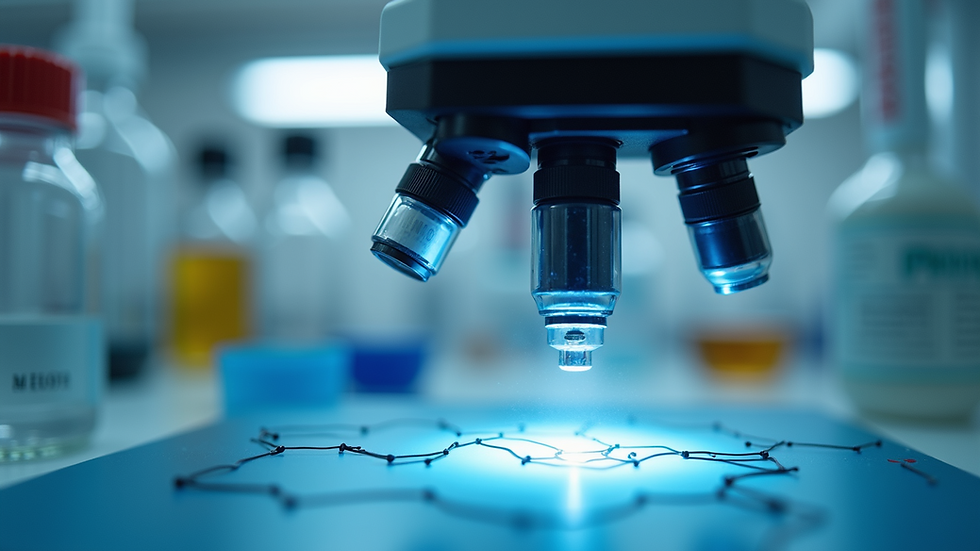Quality Assurance in Peptide Science What You Need to Know
- ScienceTide
- 3 days ago
- 3 min read
Updated: 1 day ago
Peptides play a crucial role in modern science, from drug development to diagnostics. Ensuring their quality is essential for reliable research and safe therapeutic use. This post explores the key aspects of quality assurance in peptide science, offering practical insights for researchers, manufacturers, and quality control professionals.

Why Quality Assurance Matters in Peptide Science
Peptides are short chains of amino acids that serve as building blocks for proteins and act as signaling molecules in the body. Their applications range from pharmaceuticals to biotechnology research. Because peptides influence biological processes, any impurities or inconsistencies can affect experimental results or patient safety.
Quality assurance (QA) ensures that peptides meet defined standards for purity, identity, and potency. Without rigorous QA, peptides may contain contaminants, incorrect sequences, or degradation products. These issues can lead to failed experiments, misleading data, or adverse effects in clinical use.
Key Components of Quality Assurance in Peptide Production
Quality assurance in peptide science covers several stages, from synthesis to final testing. Each step requires careful control and documentation.
1. Raw Material Verification
The process begins with verifying the quality of raw materials such as amino acids, solvents, and reagents. Suppliers should provide certificates of analysis (CoA) confirming purity and identity. Testing raw materials in-house can catch discrepancies early.
2. Controlled Peptide Synthesis
Peptides are typically synthesized using solid-phase peptide synthesis (SPPS). Maintaining consistent reaction conditions—temperature, pH, reagent concentration—is critical. Automated synthesizers help reduce human error and improve reproducibility.
3. Purification and Isolation
After synthesis, crude peptides contain by-products and truncated sequences. Purification methods like high-performance liquid chromatography (HPLC) separate the desired peptide from impurities. The choice of purification technique depends on peptide properties and intended use.
4. Analytical Testing
Analytical methods confirm peptide identity, purity, and concentration. Common techniques include:
Mass spectrometry (MS) for molecular weight confirmation
HPLC for purity assessment
Amino acid analysis for sequence verification
UV spectroscopy for concentration measurement
Regular calibration and validation of instruments ensure accurate results.
5. Stability and Storage
Peptides can degrade over time due to temperature, light, or moisture exposure. Stability testing under various conditions helps define proper storage guidelines. Lyophilization (freeze-drying) often extends shelf life.
Practical Examples of Quality Assurance Challenges
Case Study: Peptide Therapeutics
A pharmaceutical company developing a peptide drug encountered batch-to-batch variability in purity. Investigation revealed inconsistent solvent quality and incomplete removal of protecting groups during synthesis. Implementing stricter raw material testing and optimizing purification steps resolved the issue, improving product consistency.
Research Lab Experience
A research lab using custom peptides for receptor binding studies noticed unexpected biological activity. Analytical testing showed the presence of a truncated peptide variant acting as an antagonist. This finding highlighted the importance of thorough peptide characterization before biological assays.
Best Practices for Ensuring Peptide Quality
Use reputable suppliers for raw materials and peptides
Implement standard operating procedures (SOPs) for synthesis and purification
Perform comprehensive analytical testing on each batch
Document all processes and results for traceability
Train staff regularly on QA protocols and instrument use
Conduct stability studies to establish storage conditions
Emerging Trends in Peptide Quality Assurance
Advances in technology continue to improve peptide QA. For example:
Automated synthesis platforms reduce human error and increase throughput
High-resolution mass spectrometry enables detailed impurity profiling
Bioinformatics tools assist in predicting peptide stability and modifications
Real-time monitoring of synthesis reactions enhances process control
These innovations help meet growing demands for high-quality peptides in research and medicine.
What You Can Do Next
If you work with peptides, prioritize quality assurance to protect your research integrity and patient safety. Start by reviewing your current QA practices and identifying areas for improvement. Collaborate with experienced peptide manufacturers and analytical labs to ensure your peptides meet the highest standards.
Quality assurance is not a one-time task but an ongoing commitment. Staying informed about new methods and technologies will help you maintain confidence in your peptide products.
Quality assurance in peptide science safeguards the reliability and safety of peptides used across many fields. By understanding and applying key QA principles, you can avoid common pitfalls and achieve consistent, high-quality results. Take action today to strengthen your peptide quality processes and support your scientific goals.


Comments